cooling CADILLAC DEVILLE 1998 7.G User Guide
[x] Cancel search | Manufacturer: CADILLAC, Model Year: 1998, Model line: DEVILLE, Model: CADILLAC DEVILLE 1998 7.GPages: 386, PDF Size: 22.36 MB
Page 268 of 386

Downloaded from www.Manualslib.com manuals search engine If it isn’t, the coolant level should be indicated by a
CHECK COOLANT
LEVEL message on the Driver
Information Center. If it is, you may have a leak in the
radiator hoses, heater hoses, radiator, water pump or somewhere else in the cooling system.
Heater and radiator hoses, and other engine
parts, can be very hot. Don’t touch them.
If you
do, you can be burned.
Don’t run the engine if there is
a leak. If you run
the engine, it could lose all coolant. That could
cause an engine fire, and you could be burned.
Get any leak fixed before you drive the vehicle.
I NOTICE:
Engine damage if you keep running your engine
without coolant isn’t covered
by your warranty.
See “Overheated Engine Protection Operating
Mode” in the Index.
If there seems to be no leak, with the engine on, check to
see if the electric engine cooling fans are running. If the
engine is overheating, both fans should be running..
If
they aren’t, your vehicle needs service.
.
Page 269 of 386
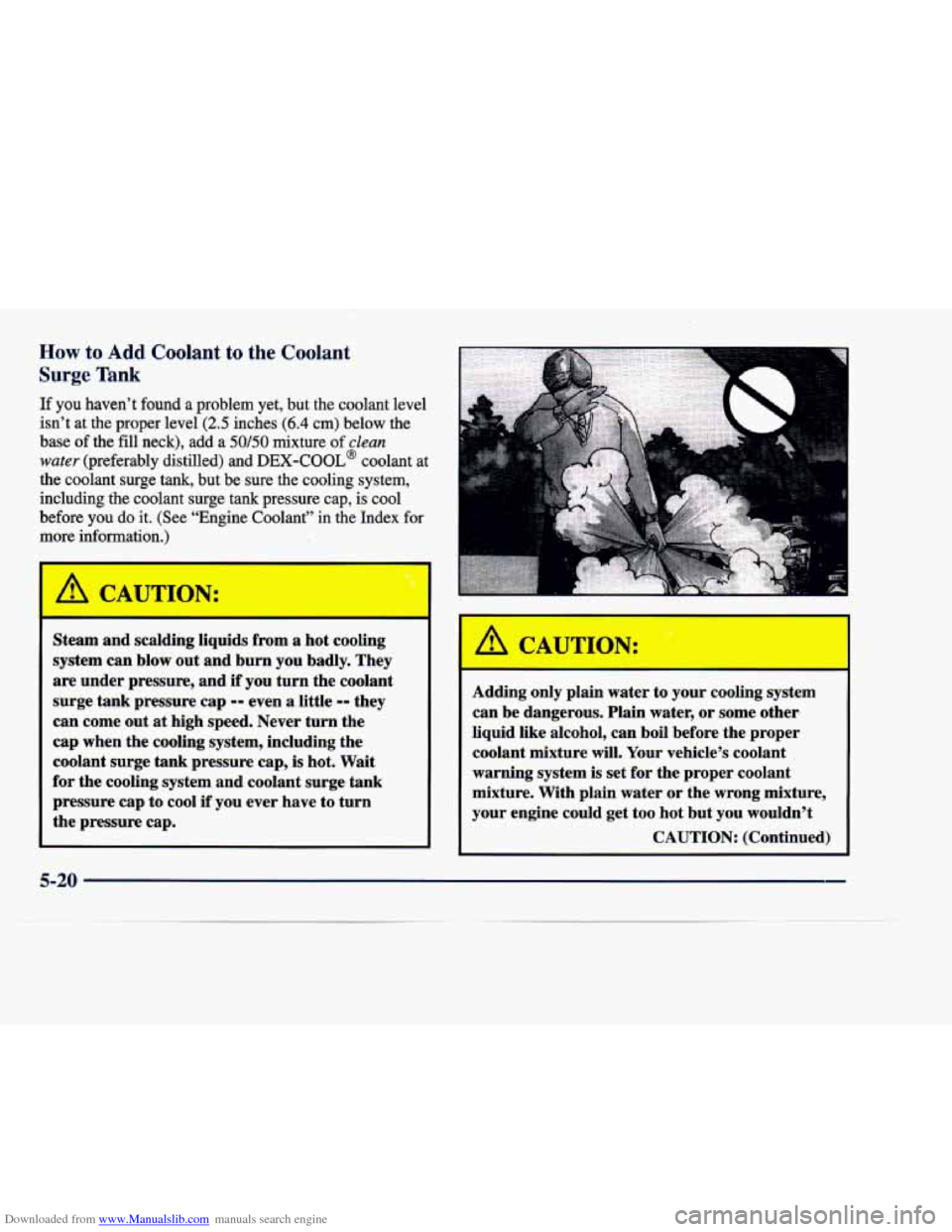
Downloaded from www.Manualslib.com manuals search engine How to Add Coolant to the Coolant
Surge Tank
If you haven’t found a problem yet, but the coolant level
isn’t at the proper level
(2.5 inches (6.4 cm) below the
base of the fill neck), add a
50/50 mixture of clean
water (preferably distilled) and DEX-COOL’ coolant at
the coolant surge tank, but be sure the cooling system,
including the coolant surge tank pressure cap, is cool
before
you do it. (See “Engine Coolant” in the Index for
more information.)
Steam and scalding liquids from a hot cooling
system can blow out and burn you badly. They
are under pressure, and if you turn the coolant
surge tank pressure cap
-- even a little -- they
can come out
at high speed. Never turn the
cap when the cooling system, including the
coolant surge tank pressure cap,
is hot. Wait
for the cooling system and coolant surge tank
pressure cap to cool
if you ever have to turn
the pressure cap. Adding
only plain water to your cooling system
can be dangerous. Plain water, or some other
liquid like alcohol, can boil before the proper
coolant mixture will. Your vehicle’s coolant
warning system
is set for the proper coolant
mixture. With plain water or the wrong mixture,
your engine could get too hot but you wouldn’t
CAUTION: (Continued)
5-20
Page 270 of 386
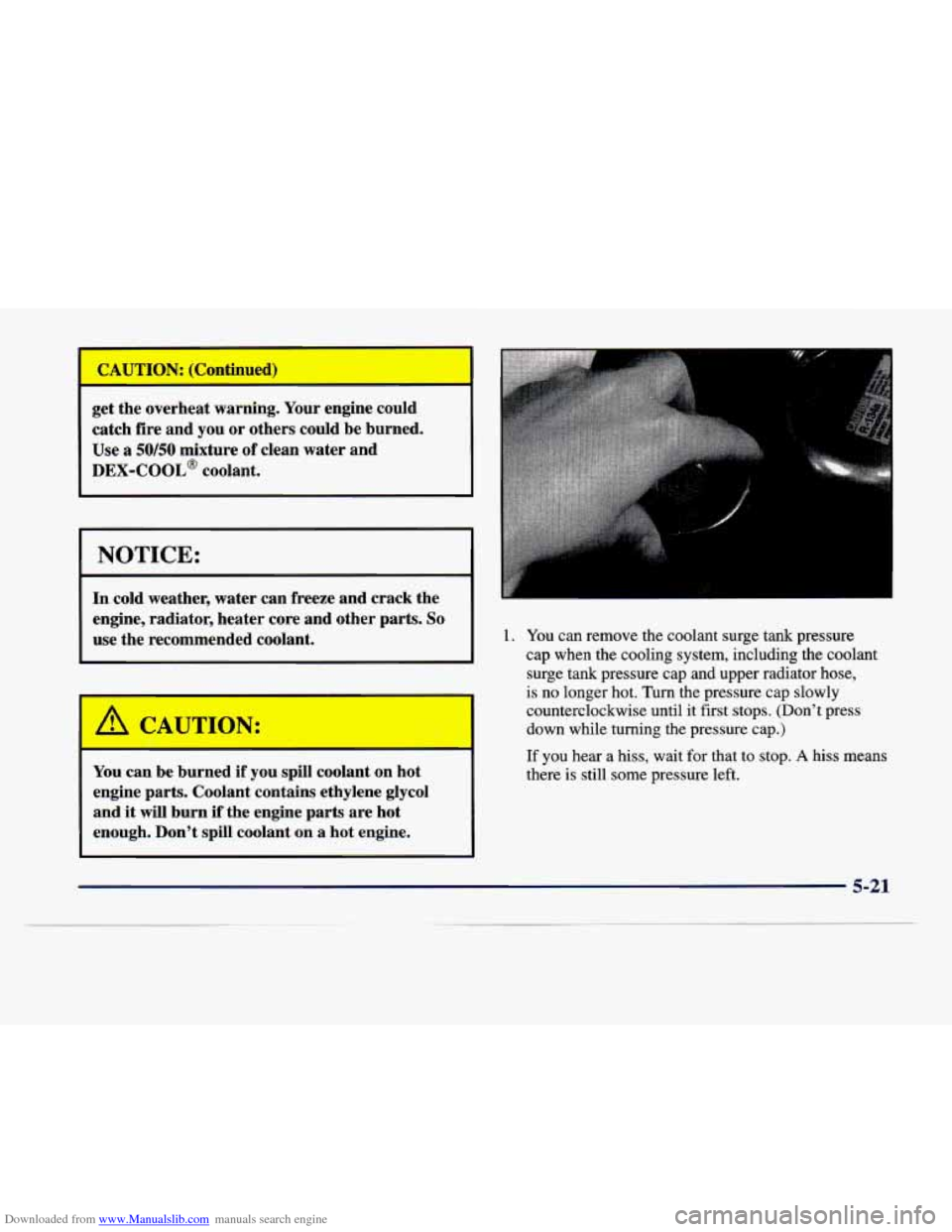
Downloaded from www.Manualslib.com manuals search engine ~- ~~ ~
get the overheat warning. Your engine could
catch fire and you or others could be burned.
Use a 50/50 mixture of clean water and
DEX-COOL@ coolant.
I NOTICE:
In cold weather, water can freeze and crack the
engine, radiator, heater core and other parts.
So
use the recommended coolant. 1. You can remove the coolant surge tank pressure
cap when the cooling system, including the coolant
surge tank pressure cap and upper radiator hose,
is no longer hot. Turn the pressure cap slowly
counterclockwise until it first stops. (Don’t press
down while turning the pressure cap.)
If you hear a hiss, wait for that to stop. A hiss means
there is still some pressure left.
You
can be burned if you spill coolant on hot
engine parts. Coolant contains ethylene glycol
and
it will burn if the engine parts are hot
enough. Don’t spill coolant on
a hot engine.
5-21
Page 272 of 386
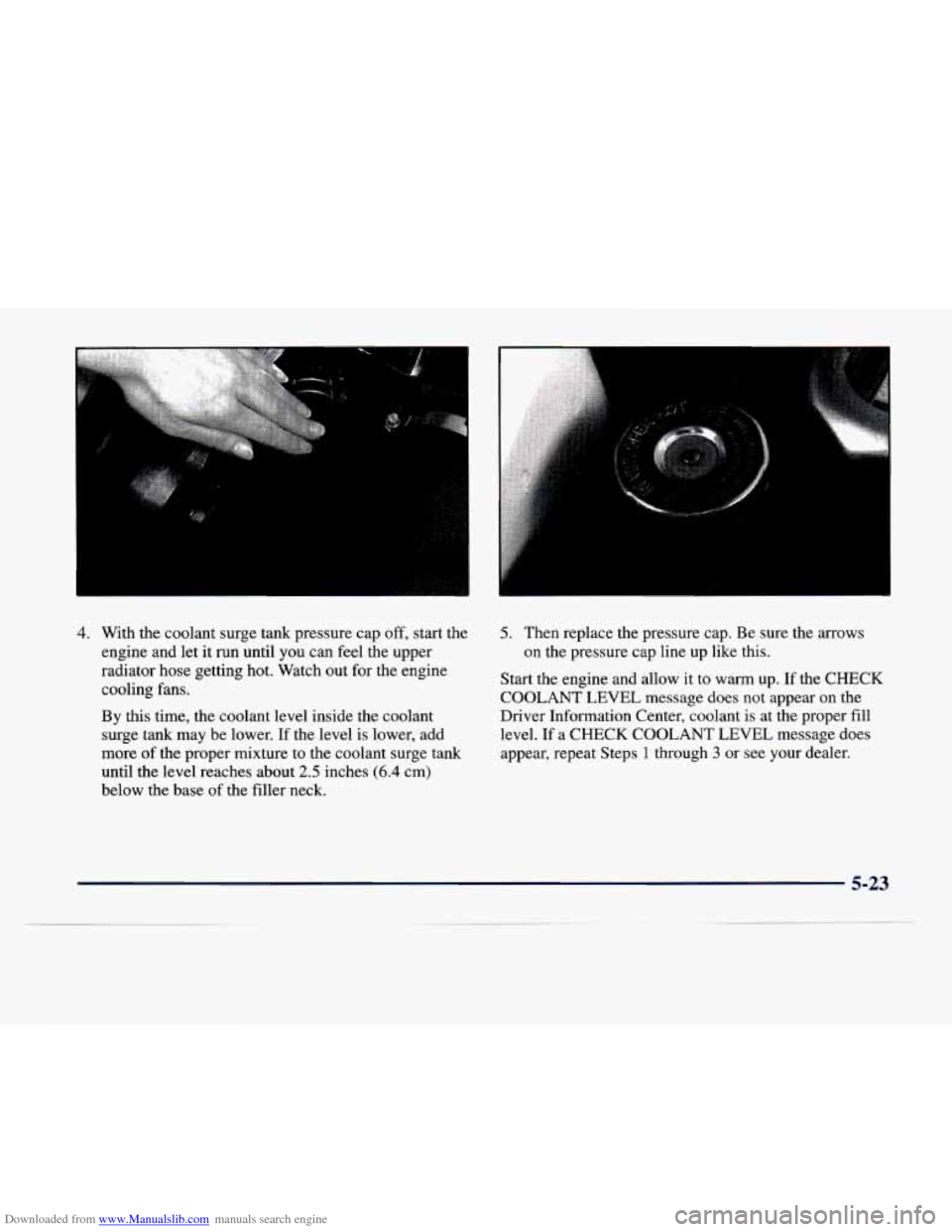
Downloaded from www.Manualslib.com manuals search engine 4. With the coolant surge tank pressure cap off, start the
engine and let it run until
you can feel the upper
radiator hose getting hot. Watch out for the engine
cooling fans.
By this time, the coolant level inside the coolant
surge tank may be lower.
If the level is lower, add
more
of the proper mixture to the coolant surge tank
until the level reaches about
2.5 inches (6.4 cm)
below
the base of the filler neck.
5. Then replace the pressure cap. Be sure the arrows
on
the pressure cap line up like this.
Start the engine and allow it to warm up. If the
CHECK
COOLANT LEVEL message does not appear on the
Driver Information Center, coolant
is at the proper fill
level.
If a CHECK COOLANT LEVEL message does
appear, repeat Steps
1 through 3 or see your dealer.
Page 309 of 386
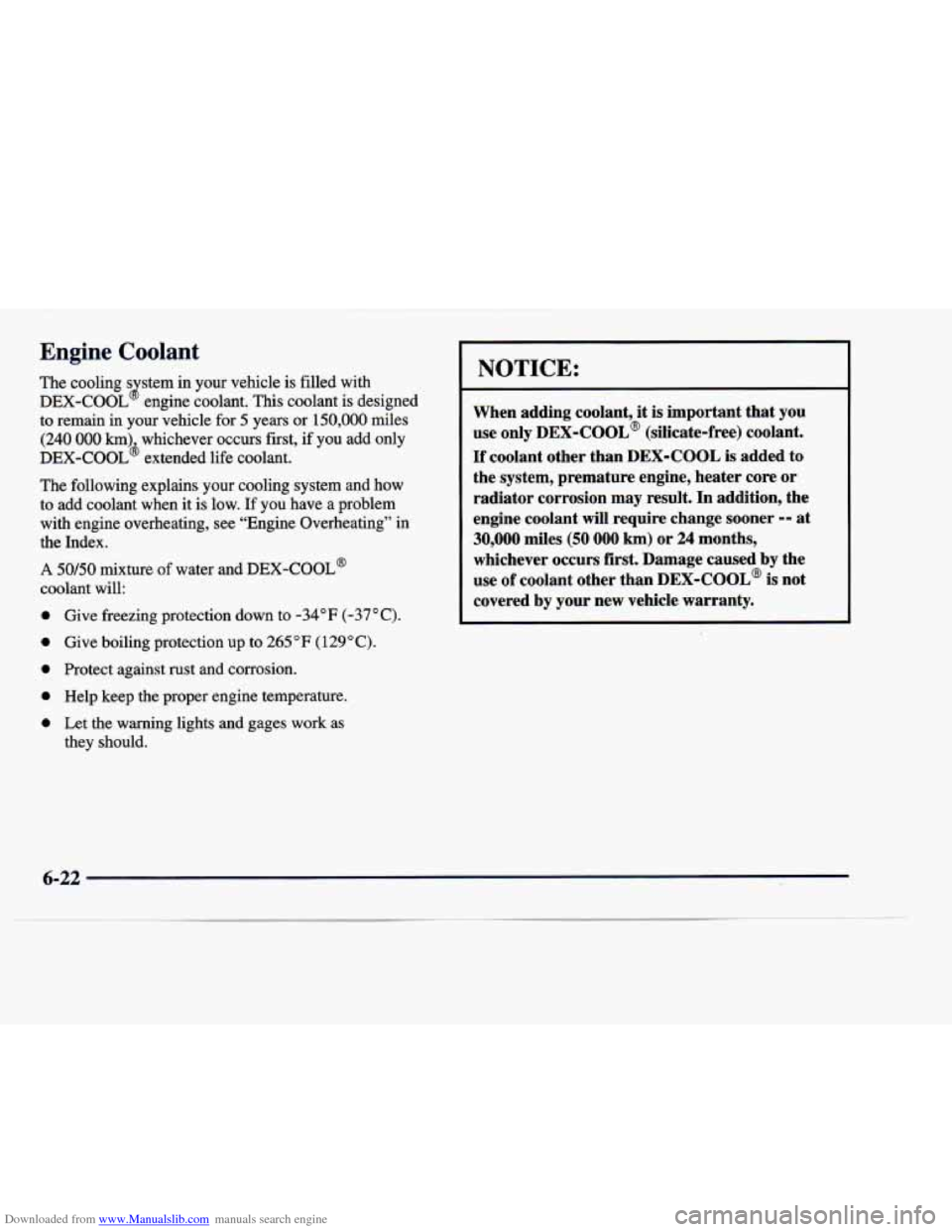
Downloaded from www.Manualslib.com manuals search engine Engine Coolant
The cooling s stem in your vehicle is filled with
DEX-COOL engine coolant.
This coolant is designed
to remain
in your vehicle for 5 years or 150,000 miles
(240 000 km) whichever occurs first, if you add only
DEX-COOL’ extended
life coolant.
B
The following explains your cooling system and how
to add coolant when it is low. If you have a problem
with engine overheating, see “Engine Overheating” in
the Index.
A 50/50 mixture of water and DEX-COOL’
coolant will:
0 Give freezing protection down to -34°F (-37°C).
0 Give boiling protection up to 265 “F ( 129 O C).
0 Protect against rust and corrosion.
0 Help keep the proper engine temperature.
0 Let the warning lights and gages work as
they should.
NOTICE:
When adding coolant, it is important that you
use only DEX-COOL@ (silicate-free) coolant.
If coolant other than DEX-COOL is added to
the system, premature engine, heater core or
radiator corrosion may result. In addition, the
engine coolant will require change sooner
-- at
30,000 miles (50 000 km) or 24 months,
whichever occurs first. Damage caused by the
use
of coolant other than DEX-COOL’ is not
covered by your new vehicle warranty.
6-22
Page 310 of 386

Downloaded from www.Manualslib.com manuals search engine What to Use
Use a mixture of one-half clean water (preferably
distilled) and one-half
DEX-COOL@ coolant which
won’t damage aluminum
parts. If you use this mixture,
you don’t need to add anything else.
I
Adding only plain water to your cooling system
can be dangerous. Plain water, or some other
liquid like alcohol, can boil before the proper
coolant mixture will. Your vehicle’s coolant
warning system
is set for the proper coolant
mixture. With plain water or the wrong mixture,
your engine could get too hot but you wouldn’t
get the overheat warning. Your engine could
catch fire and you or others could be burned.
Use a
50/50 mixture of clean water and
DEX-COOL@ coolant.
NOTICE:
If you use an improper coolant mixture, your
engine could overheat and be badly damaged.
The repair cost wouldn’t be covered by your
warranty.
Too much water in the mixture can
freeze and crack the engine, radiator, heater core
and other parts.
If you have to add coolant more than four times a year,
have your dealer check your cooling system.
NOTICE:
If you use the proper coolant, you don’t have to
add extra inhibitors or additives which claim to
improve the system. These can be harmful.
6-23
Page 311 of 386
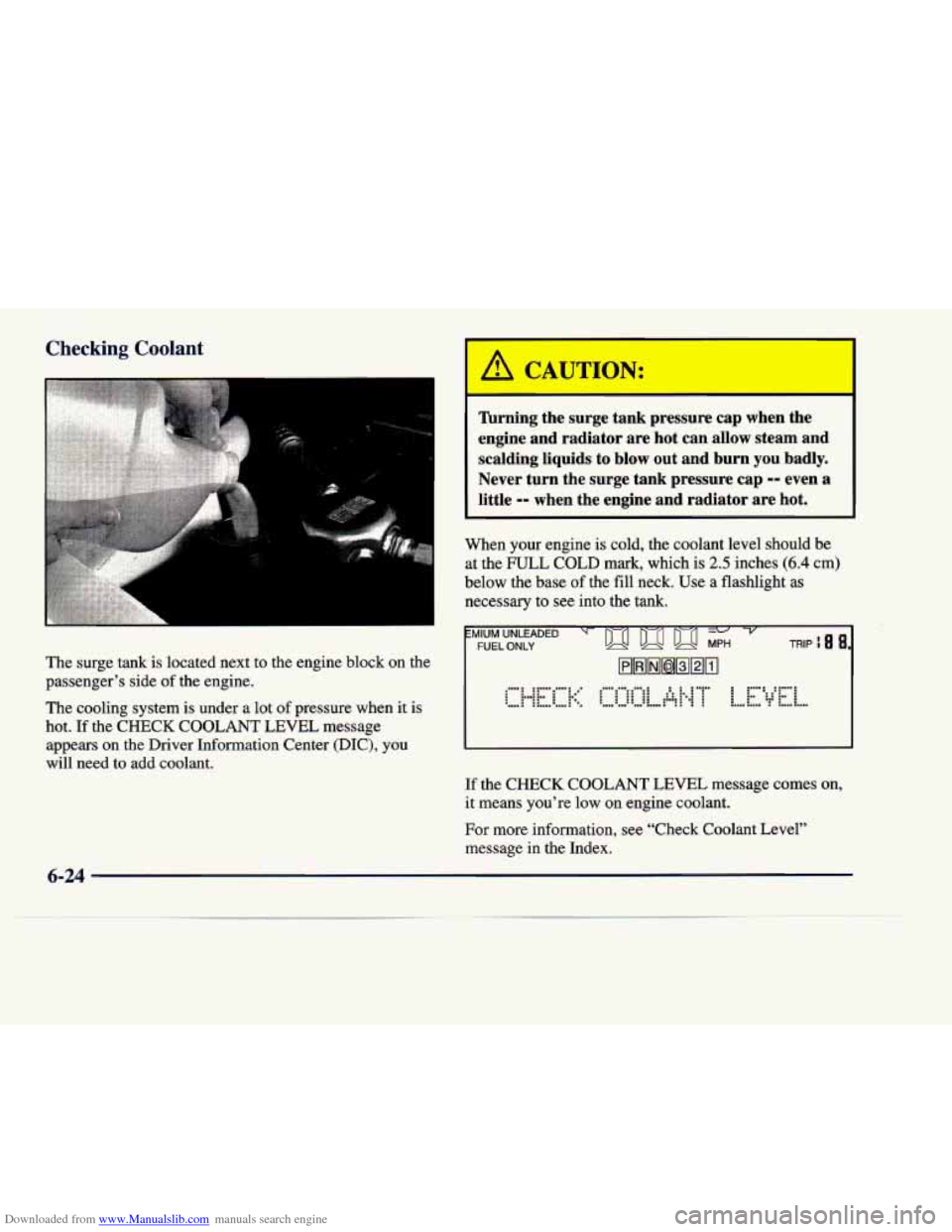
Downloaded from www.Manualslib.com manuals search engine Checking Coolant
L
The surge tank is located next to the engine block on the
passenger's side of the engine.
The cooling system is under a lot of pressure when it is
hot.
If the CHECK COOLANT LEVEL message
appears on the Driver Information Center (DIC), you
will need to add coolant.
l'brning the surge tank pressure cap when the
engine and radiator are hot can allow steam and
scalding liquids to blow
out and burn you badly.
Never turn
the surge tank pressure cap -- even a
little
-- when the engine and radiator are hot.
When your engine is cold, the coolant level should be
at the
FULL COLD mark, which is 2.5 inches (6.4 cm)
below the base
of the fill neck. Use a flashlight as
necessary to
see into the tank.
~MIUM UNLEADED -
-
FUEL ONLY IJIJ DJ DJ MK
HHrnrnrnrn
If the CHECK COOLANT LEVEL message comes on,
it means you're low on engine coolant.
For more information, see "Check Coolant Level"
message in the Index.
Page 334 of 386
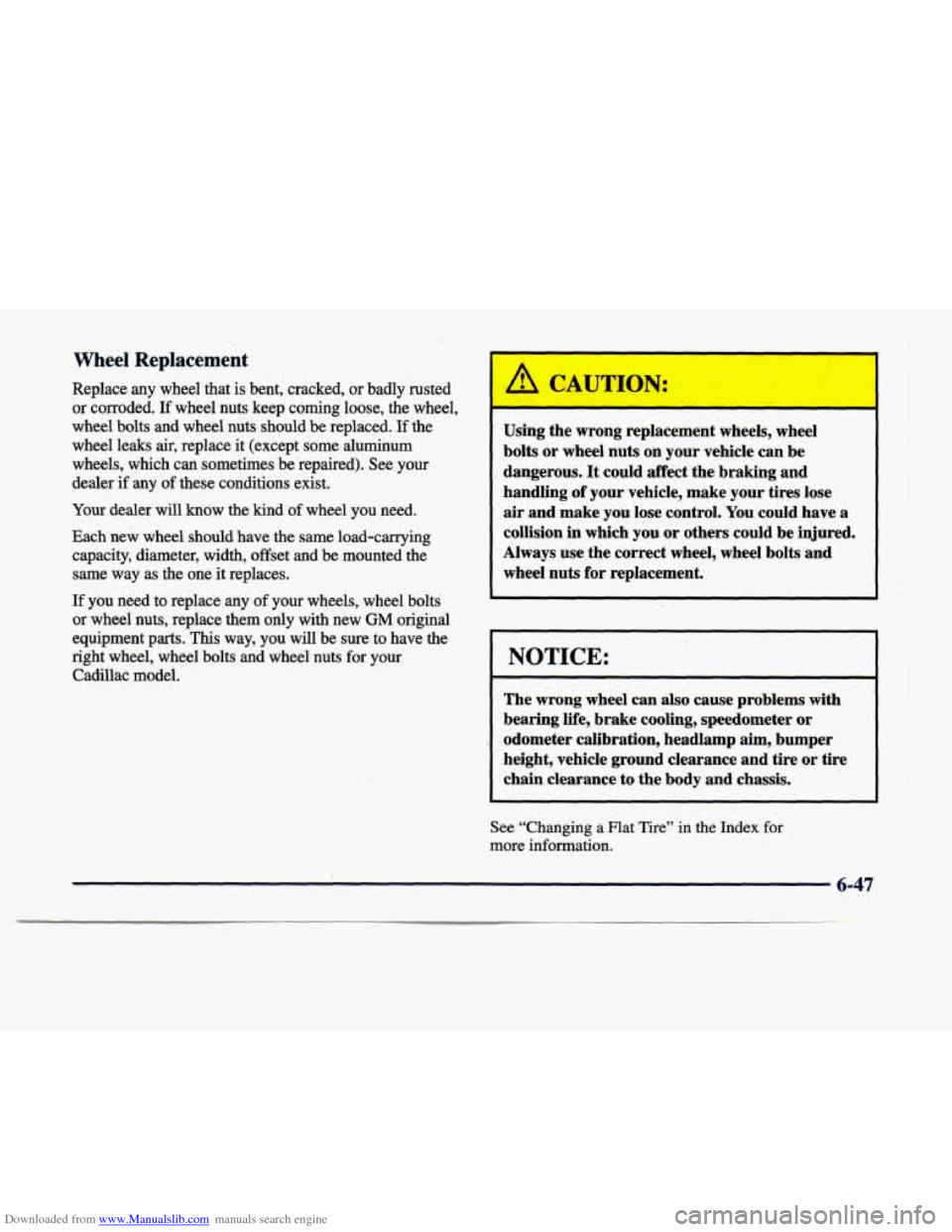
Downloaded from www.Manualslib.com manuals search engine Wheel Replacement
Replace any wheel that is bent, cracked, or badly rusted
or corroded.
If wheel nuts keep coming loose, the wheel,
wheel bolts and wheel nuts should be replaced. If the
wheel leaks
air, replace it (except some aluminum
wheels, which can sometimes be’repaired). See your
dealer
if any of these conditions exist.
Your dealer
will know the kind of wheel you need.
Each
new wheel should have the same load-carrying
capacity, diameter, width, offset and be mounted the
same way as the one it replaces.
If you need to replace any of your wheels, wheel bolts
or wheel nuts, replace them only with new
GM original
equipment parts.
This way, you will be sure to have the
right wheel, wheel bolts and wheel nuts for your Cadillac model.
Using the wrong replacement wheels, wheel
bolts or wheel nuts on your vehicle can be
dangerous.
It could affect the braking and
handling
of your vehicle, make your tires lose
air and make you lose control. You could have a
collision in which you or others
could be injured.
Always use the correct wheel, wheel bolts and
wheel nuts
for replacement.
NOTICE:
The wrong wheel can also cause problems with
bearing life, brake cooling, speedometer
or
-odometer calibration, headlamp aim, bumper
height, vehicle ground clearance and tire or tire
chain clearance to the body and chassis.
See “Changing a Flat Tire” in the Index for
more information.
Page 347 of 386
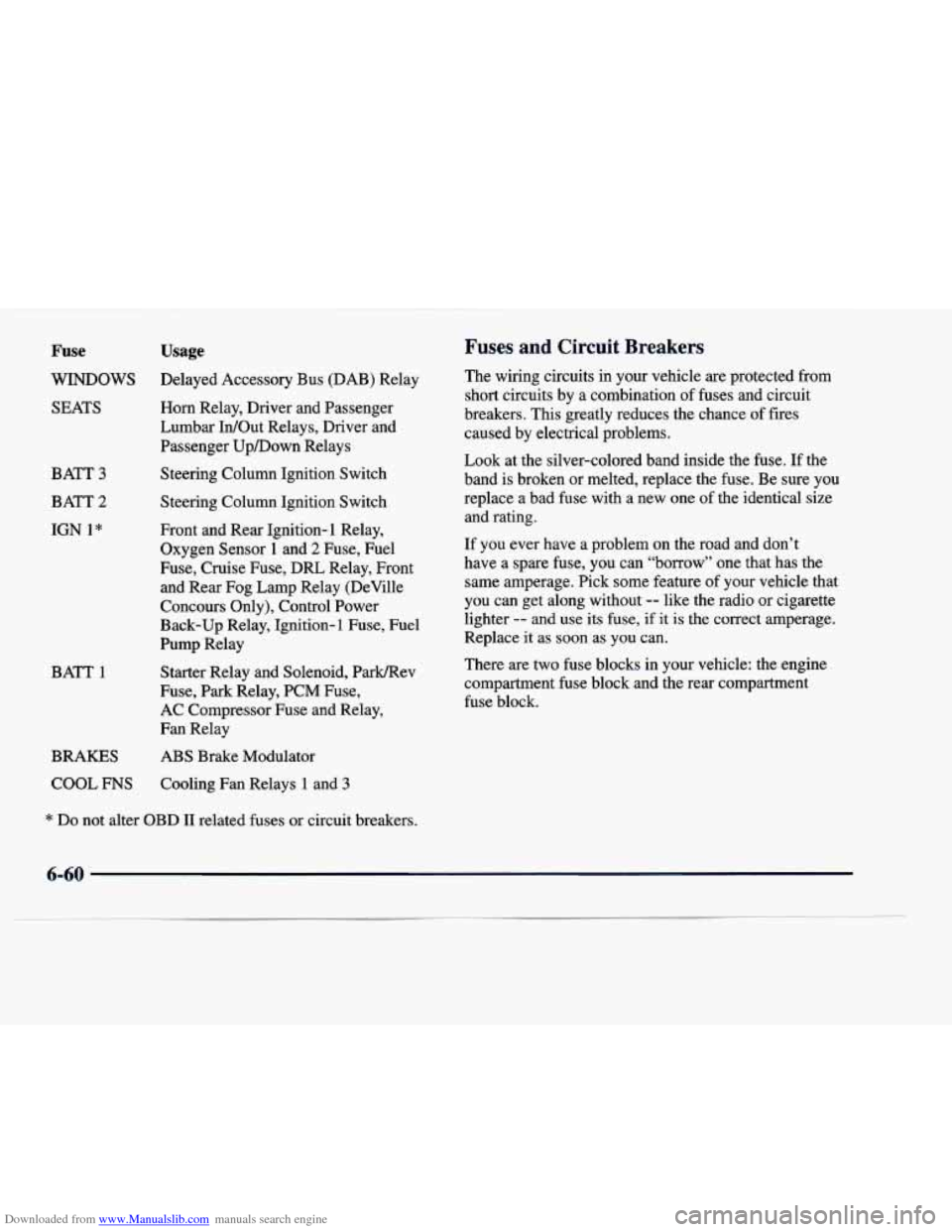
Downloaded from www.Manualslib.com manuals search engine Fuse Usage
WINDOWS Delayed Accessory Bus (DAB) Relay
SEATS
Horn Relay, Driver and Passenger
Lumbar IdOut Relays, Driver and
Passenger Upmown Relays
BATT
3
BATT 2
IGN 1”
BATT 1
BRAKES Steering Column Ignition Switch
Steering Column Ignition Switch
Front and Rear Ignition-
1 Relay,
Oxygen Sensor
1 and 2 Fuse, Fuel
Fuse, Cruise Fuse, DRL Relay, Front
and Rear Fog Lamp Relay (DeVille
Concours Only), Control Power
Back-up Relay, Ignition-1 Fuse, Fuel
Pump Relay
Starter Relay and Solenoid, Park/Rev
Fuse, Park Relay, PCM Fuse,
AC Compressor Fuse and Relay,
Fan Relay
ABS Brake Modulator
COOL FNS Cooling Fan Relays 1 and 3
* Do not alter OBD 11 related fuses or circuit breakers.
Fuses and Circuit Breakers
The wiring circuits in your vehicle are protected from
short circuits by a combination of fuses and circuit
breakers. This greatly reduces the chance of fires
caused by electrical problems.
Look at the silver-colored band inside the fuse. If the
band
is broken or melted, replace the fuse. Be sure you
replace a bad fuse with a new one
of the identical size
and rating.
If you ever have a problem on the road and don’t
have a spare fuse, you can “borrow” one that has the same amperage. Pick some feature
of your vehicle that
you can get along without
-- like the radio or cigarette
lighter
-- and use its fuse, if it is the correct amperage.
Replace it as soon as you can.
There are two fuse blocks in your vehicle: the engine
compartment fuse block and the rear compartment
fuse block.
6-60
Page 350 of 386
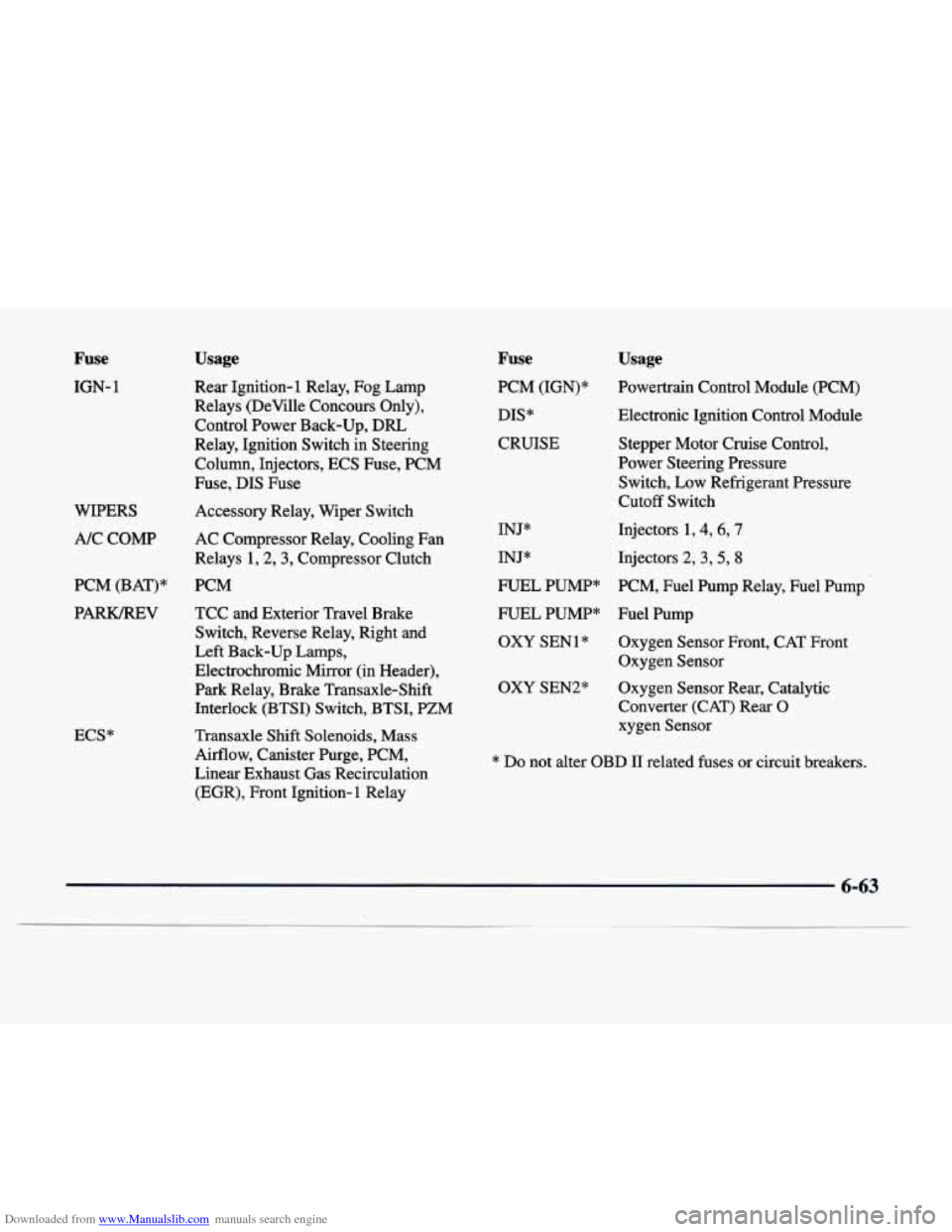
Downloaded from www.Manualslib.com manuals search engine Fuse
IGN- 1
WIPERS
A/C COMP
PCM (BAT)*
PARKREV
ECS*
Usage
Rear Ignition- 1 Relay, Fog Lamp
Relays (DeVille Concours Only),
Control Power Back-up, DlU
Relay, Ignition Switch in Steering
Column, Injectors, ECS Fuse, PCM
Fuse, DIS Fuse
Accessory Relay, Wiper Switch
AC Compressor Relay, Cooling Fan
Relays 1,2,3, Compressor Clutch
PCM
TCC and Exterior Travel Brake
Switch, Reverse Relay, Right and
Left Back-up Lamps,
Electrochromic Mirror (in Header),
Park Relay, Brake Transaxle-Shift
Interlock (BTSI) Switch, BTSI, PZM
Transaxle Shift Solenoids, Mass
Airflow, Canister Purge, PCM,
Linear Exhaust Gas Recirculation (EGR), Front Ignition-
1 Relay
Fuse Usage
PCM (IGN)* Powertrain Control Module (PCM)
DIS*
CRUISE
INJ*
Electronic Ignition Control Module Stepper Motor Cruise Control,
Power Steering Pressure Switch, Low Refrigerant Pressure
Cutoff Switch
Injectors 1,4,6,7
INJ* Injectors 2, 3, 5, 8
FUEL PUMP* PCM, Fuel Pump Relay, Fuel Pump
FUEL PUMP* Fuel Pump
OXY SEN1 * Oxygen Sensor Front, CAT Front
Oxygen Sensor
OXY SEN2* Oxygen Sensor Rear, Catalytic Converter (CAT) Rear
0
xygen Sensor
* Do not alter OBD I1 related fuses or circuit breakers.
6-63